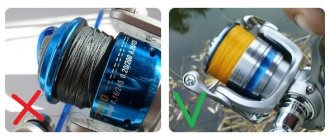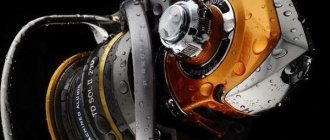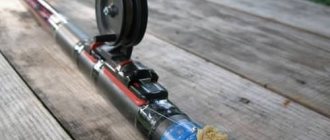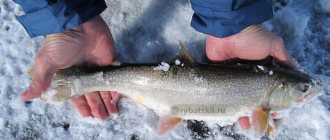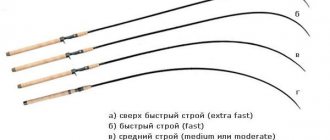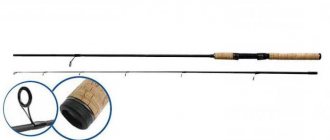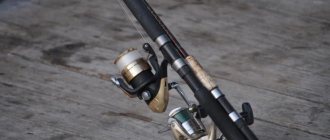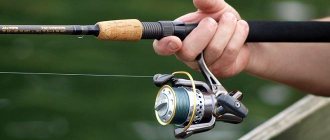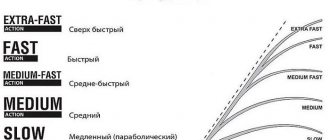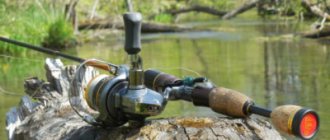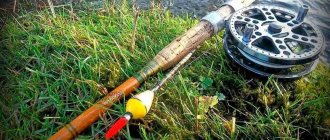Among the many manufacturers of components for spinning, special attention has always been paid to manufacturers of reels; inertia-free reels for this type of fishing require only good quality. The Japanese company Ryobi has long been one of the leaders in sales of such products; the quality of its products has always been at the proper level and still does not lose its position.
The lineup is periodically replenished with new models, but most anglers remain faithful to the choice they made many years ago.
A little about the company
Ryobi products are known all over the world; few fishermen have never heard of this name. Ryobi is now a major manufacturer of fishing tackle. But they started from something completely different.
In the early 40s of the last century, the company Ryobi was registered in Japan, which was engaged in the production of various aluminum components for workshops. After 30 years, it was decided to retrain and launch our own production of finished products, and the direction chosen was fishing.
Victoria Leshchenko
I've been working hard in the fishing tackle department for the past six years. I can help you assemble almost any gear.
Ask a Question
Within 10 years, Riobi won the recognition of many fishing enthusiasts, and 20 years later it reached the world level in terms of brand popularity. Now Riobi is extremely popular; excellent quality and relatively low price only increase the demand for its products.
Spinning line
The fishing line is an important element of spinning tackle; it serves as a connecting link between the bait and the rod. There are three main types of fishing lines used in spinning rods: monofilament, braided fishing line (cords) and fluorocarbon fishing line. Each of these types of fishing line has its own characteristics, advantages and disadvantages.
- Monofilaments
are the oldest type of fishing line. Mono lines have a low cost, low visibility in the water, due to their stretchability, they are good at damping fish jerks. The disadvantages of monofilament include low strength and stretchability, due to which they do not provide high sensitivity of the gear. - Braided fishing lines (cords)
do not consist of one fiber, like monofilaments and fluorocarbon fishing lines, but of several fibers woven together. Braided fishing lines are practically inextensible, which ensures full contact with the bait and the highest sensitivity of the gear. Braided fishing lines have high tensile strength, exceeding the strength of all other types of fishing line. With the same diameter, braided fishing line is 3-5 times stronger than monofilament. Braided fishing lines, unlike monofilaments, do not have a memory effect. Without the use of braided lines, it is impossible to imagine such methods of spinning fishing as jig, twitching and jerking. The disadvantages of braided lines are their higher cost, as well as their increased susceptibility to abrasion. - Fluorocarbon lines
have a light refractive index close to that of water, so they are almost completely invisible in water. Another significant advantage of fluorocarbon fishing lines is their high abrasion resistance.
You may be interested in: Fishing in the Moscow region
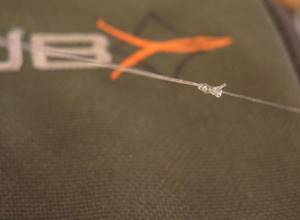
When catching predatory fish that have sharp teeth that can easily cut the fishing line, the fisherman attaches a leash between the main fishing line and the bait. The leash can be made of different materials: metal braided cable, guitar string, fluorocarbon or monofilament. The most common are leashes made of metal braided cable; they can be of different lengths and workmanship; they can be bought at any fishing store. Popular among spinning anglers are leashes made of guitar string or other steel wire with a diameter of 0.18 to 0.40 mm. Many anglers use a piece of fluorocarbon fishing line with a diameter of 0.35 - 0.7 mm for the leash.
Terms of use
Spinning reels from Riobi and other manufacturers must be used correctly for long-term operation. Mistakes in this matter can be very expensive, and sometimes it can result in complete incapacity of the product.
For everything to work perfectly, you must adhere to the following rules:
- There is no need to lubricate it immediately after purchasing a new coil, but it is better to give a used product for preventive maintenance;
- it is necessary to wind the line or cord with the bracket lowered, passing through the line layer;
- winding is carried out only with a tightly stretched base; the slightest sagging can subsequently cause loops and beards;
- when fishing, under no circumstances should you allow water, or especially sand, to get under the spool body;
- When moving from place to place, it is advisable to fold the handle, this will help avoid minor damage.
In addition, every year after the end of the spinning season, usually in late autumn or early winter, it is worth carrying out preventive measures. You need to lubricate thoroughly, but there should not be a large amount of oil in the coil.
Ryobi reel prices
- Ryobi Oasis. A series of universal-purpose reels using steel bearings in eight sizes. Price from 750 rubles.
- Riobi Arctica (5+1). Six bearing reel using titanium nitrite on key parts. Cost from 8,000 – 11,000 rubles.
- Ryobi CF-Arctica (7+1). A series of new spinning reels. The main difference is the presence of additional ball bushings and an increased strength housing. Approximate price from 7700 – 12000 rub. Depending on the place of purchase.
- Ryobi Applause. Standard 4 bearing model with instantaneous friction brake. Designed for extreme conditions. It will cost from 7000 to 9000 rubles.
- Ryobi Ecusima reels (5+1). Excellent budget tackle with a reliable and high-quality mechanism and smooth running, as well as a standard line-laying arm. Perfect for beginners. Cost 1200 rubles.
- Ryobi Proskyer (4+1+1). Surf gear with low gear ratio. Excellent, wide-functional brake allows for precise adjustment. Allows for incredibly long casts. The standard kit includes two spare spools. The price ranges from 900 – 1700 depending on the configuration.
- Ryobi Fishing Safari (6+1). It is the most powerful feeder tackle with 7 bearings. Increased structural strength includes the use of an endless screw on support bearings and a friction brake for precise adjustment. Designed for professionals, for whom it will be an excellent tool. Cost 9300 rubles.
- Ryobi Ixorne Aquila CF (6/8+1). A low-profile reel designed for casting all types of baits, as well as for jig fishing with unhooked hooks and light trolling. There is a brake switch mounted on the housing. Body made of metal. Can be purchased for RUR 3900.
How to choose a reel
Choosing a reel for a fishing rod is not as difficult as it seems at first glance. In order for everything to comply with the specified standards, you need to know the following form parameters:
- length;
- casting.
Based on these indicators, the size of the spool is selected. Usually, the larger the casting and the longer the rod, the larger the spool. Ideally it would be like this:
- A 1000 spool is suitable for spinning rods with a small cast; this reel option is ideal for ultralights and some lights;
- Size 2000 is set for forms whose test starts from 5 g; according to experienced fishermen, the maximum casting should be no more than 25;
- 3000 is selected for forms from 270 cm in length, while the maximum test of the rod exceeds 30 g.
Different spool sizes will hold different amounts of cord or fishing line; the larger the spool, the more spacious it is.
The bearings of these reels are rarely looked at; the manufacturer conscientiously fulfills the stated parameters. If there are 3 to 5 bearings, the reel will work just fine, and an additional one in the line guide will significantly extend the service life of the product.
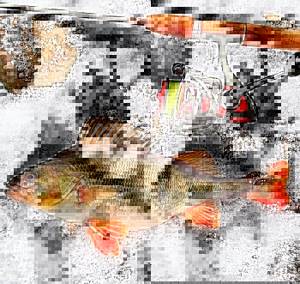
Spinning rod
The rod is the main element of spinning tackle; the success of fishing largely depends on it. In its shape, a spinning rod is a thin, long cone, the thick end of which, on which the handle is located, is called the butt, and the thin, opposite end is called the tip.
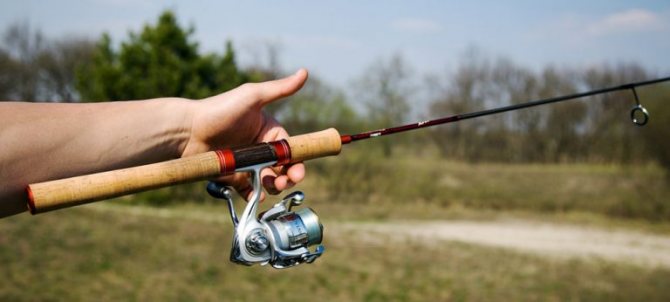
A spinning rod must be durable, light in weight, and provide high sensitivity. Spinning rods differ in the material from which they are made, test, class and length.
Spinning material
Modern spinning rods have high demands on strength and weight. The spinning rod can be made of carbon fiber, fiberglass, bamboo or metal.
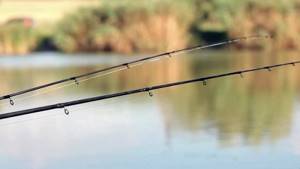
- Fiberglass is a popular material for the manufacture of spinning rods, but is now almost completely replaced by carbon fiber spinning rods. Fiberglass spinning rods are heavy and flexible. Inexpensive spinning rods are most often made from fiberglass. Fiberglass rods are often used as spinning rods for trolling.
- Carbon fiber is the most modern material for making spinning rods. Carbon fiber for spinning rods is also called carbon and graphite. Carbon fiber spinning rods have low weight, good rigidity and high flexibility. The properties of a carbon fiber spinning rod depend on the modulus of the graphite content. The higher the modulus of the graphite from which the spinning rod is made, the more rigid and sensitive the rod will be, but at the same time more fragile, requiring more careful handling.
- Composite - the spinning rod is made from a mixture of fiberglass and carbon fiber. Composite spinning rods combine the best qualities of both materials and have optimal strength and good rigidity.
- Metal - in the old days, many spinning rods were made of metal. They had high strength, but quite a lot of weight. Currently, metal spinning rods are almost out of use.
- Bamboo is a popular material for making spinning rods in the past. Bamboo spinning rods were quite durable and significantly lighter in weight than metal spinning rods. Currently, bamboo spinning rods, like metal spinning rods, are practically out of use.
Spinning test
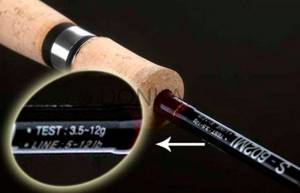
The spinning test is the weight of the lures recommended by the spinning rod manufacturer. The spin test can be reported in grams or ounces. When designating a spinning test, two values are indicated: the minimum weight of the bait that can be thrown by this rod and the maximum weight of the bait that can be thrown by this spinning rod without overloading the rod blank. The angler should follow the bait weight recommendations specified by the spinning rod manufacturer. When casting a bait weighing less than the minimum spinning test, the angler will not be able to cast it a decent distance, and will also not be able to feel the action of the bait when retrieving it. When casting a bait weighing more than the maximum spinning rod test, the rod is overloaded, which can lead to breakage of the rod blank. The spinning test is directly related to the class of the rod.
Spinning rod class
The spinning class directly depends on the test of the spinning rod and indicates its power, in terms of the weight of the baits it throws. The division of spinning rods into classes is quite arbitrary and differs among different manufacturers.
Traditionally, spinning rods are divided into 4 main classes: ultra-light, light, medium and heavy classes. In addition, some manufacturers of spinning rods distinguish intermediate classes.
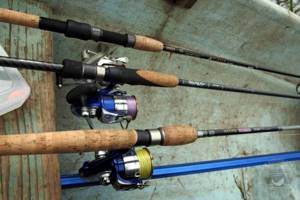
- Ultra Light class - with an upper dough limit of up to 7 grams. Ultra-light class spinning rods are designed for fishing with small spinners, small oscillating spoons, microjigs and small wobblers. Ultralight spinning is most often used to catch fish weighing no more than 1.5-2 kg. Most often these are small perches and pikes, chubs, graylings and trout. The length of an ultralight spinning rod is most often 1.6-2.1 meters.
- Light class (Light) - spinning rods with a dough of 7-15 grams. Rotating and oscillating spoons, jigs and wobblers are used as bait. Light-class spinning rods can catch fish weighing up to 4-5 kg. The length of rods most often ranges from 2.1 to 2.4 meters.
- Middle class (Medium) - spinning rods with a dough of 15-40 grams. When fishing with a middle-class spinning rod, heavy rotating and oscillating spoons, jig baits and large wobblers are used as bait. With a middle class spinning rod you can successfully catch large fish weighing up to 6-8 kg: pike, pike perch, asp, small catfish, taimen and salmon. The length of middle class rods most often ranges from 2.4 to 3.3 meters.
- Heavy class - spinning rods with a dough of 40 grams or more. Heavy class spinning rods are used for catching the largest trophies: pike, walleye, catfish. Heavy class rods are used for sea trolling fishing.
You may be interested in: Favorite Professional spinning rod
Length
Spinning rod manufacturers produce spinning rods in a variety of sizes designed to catch a wide variety of fish in a variety of conditions. European manufacturers of spinning rods measure the length of spinning rods in meters, American manufacturers traditionally indicate the length of spinning rods in feet and inches.
Most spinning rods have a length from 160 to 360 cm. The longer the spinning rod, the longer the cast can be made with it, but as the length of the spinning rod increases, its weight increases and its maneuverability decreases. Long spinning rods are designed for fishing in large open reservoirs and for fishing from the shore. Shorter spinning rods are designed for fishing on small rivers with overgrown banks, as well as for fishing from a boat.
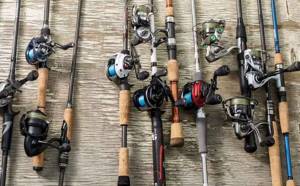
Most modern spinning rods are available in a two-part version. They are most convenient for transportation, easy to manufacture and have good technical characteristics.
Single-legged spinning rods are available, they are quite rare and are intended for special purposes, for example for casting competitions.
For those fishermen who travel a lot, there are special multi-part fishing rods called travel. Recently, telescopic spinning rods have become increasingly common, which usually consist of 5-6 telescopic parts.
Spinning rod structure
The structure of a spinning rod is the most important characteristic of a fishing rod. The casting distance of this spinning rod, as well as the sensitivity of the spinning rod, depends on the structure of the rod.
The action of a spinning rod is determined by the time it takes for the rod to return to its original state after casting. The closer the spinning rod's action is to fast, the stiffer it is and the higher its sensitivity, the better all the vibrations are transmitted to the angler's hand, but as the rigidity of the spinning rod increases, the casting range of the bait decreases.
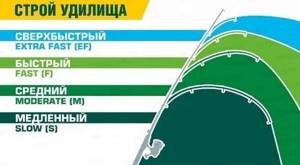
In order to determine the structure of a spinning rod, you need to look at where the spinning rod bends under load. With an ultra-fast action spinning rod, only the very tip of the spinning rod bends, while with a slow action spinning rod, the entire spinning rod bends under load.
Based on the action, there are spinning rods of super-fast, fast, medium and slow action.
- Extra Fast action
– only the very tip of the spinning rod bends, no more than ¼ of the length of the rod. An ultra-fast spinning rod is well suited for twitching and jig fishing. Ultra-fast spinning rods have maximum sensitivity, but have a shorter casting range and are less effective at softening the jerks of fish when playing. - Fast action
- under load, the spinning rod bends from half the length of the rod. Fast action spinning rods are also mainly used for twitching and jigging. - Medium action (Moderate)
– a medium action spinning rod bends up to ¾ of its length. The most universal and common rod structure among anglers. Can be used for fishing with a wide variety of spinning lures. - Slow action
– the spinning rod bends along its entire length; this spinning rod action is often called a “parabolic” action. Slow action spinning gives the longest cast and softens the jerks of the fish well when playing. Slow-action spinning rods are best suited for fishing with rotating and oscillating spoons; they are poorly suited for twitching and jigging.
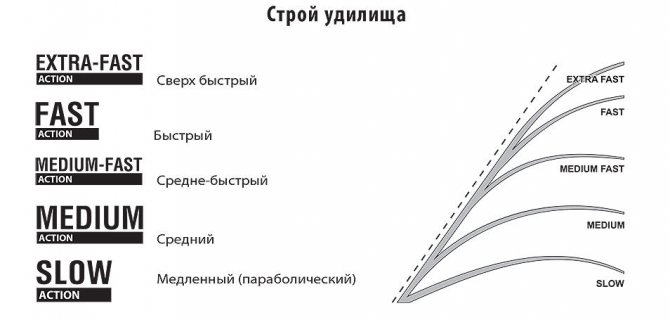
Some manufacturers of spinning rods produce models of spinning rods not only of the 4 main types of action, but also intermediate ones, for example, medium-fast (ModerateFast). In addition, some manufacturers indicate the recommended method of fishing with this spinning rod, for example, a spinning rod for twitching or jigging.
Estimated fishing location
Very often, the choice of spinning rod depends on the body of water where you plan to fish.
When fishing at sea, as well as in the northern and eastern regions of Russia, large and strong fish are often caught, so you should use the most powerful and durable spinning rods.
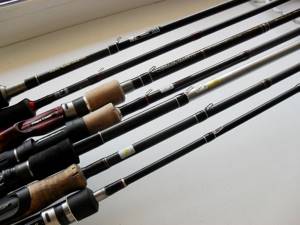
When fishing on a large lake, large reservoir or large river (more than 10 meters wide), where there are often deep waters and strong winds, you should use long, stiff spinning rods. Fishing in such conditions is most often carried out using jig heads with silicone baits, rotating and oscillating spoons, and wobblers. The optimal spinning rod length for these conditions will be 2.8-3 meters, the rod action is Fast or Extra Fast, the test weight is from 7 to 30 grams.
For fishing on a medium-sized pond, lake and river, a spinning rod with a length of 2.1-2.4 meters, a Fast or Extra Fast action, and a test weight of 3-15 grams is well suited. For fishing in such conditions, small spoons, microjigs and small wobblers are used.
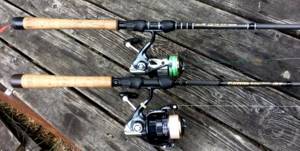
When fishing on a small river or stream, with banks overgrown with trees and bushes, you should use a spinning rod of small length 160-180 cm, with a fast action and a cast of 1 to 7 grams. This rod allows you to make precise casts in cramped conditions.
When fishing from a boat or boat, you should use a rod with a length of 210-240 cm, Extra Fast action, test up to 28 or up to 40 grams. Fishing is most often done with jigs and wobblers.
How to distinguish an original from a fake
Lately there have been a lot of counterfeits of Riobi reels of various models on the market. Chinese craftsmen, and representatives of other nationalities, copy products for profit. But it won’t be possible to do absolutely everything, since certain components are quite expensive.
Models Exia, Zauber, Arctica in the original have an endless screw; pirated copies do not have this element. This can be discovered simply by carefully disassembling the coil.
Victoria Leshchenko
I've been working hard in the fishing tackle department for the past six years. I can help you assemble almost any gear.
Ask a Question
It will be more difficult to identify counterfeits of other models; you shouldn’t trust inscriptions and stickers; in the age of high technology, you can print and stick anything.
Advantage of Ryobi reels
The undeniable advantages of Riobi coils are high quality and fairly low cost.
A feature that distinguishes this manufacturer is the body design, made entirely of metal. Aluminum alloys are also used for the spool and rotor.
The design of the bow ensures the precision of the line coming off onto the roller, which is made in the form of a cone.
Many mechanisms have an “endless” screw in their structure, which ensures impeccable laying and winding of fishing line; they are excellent for using the so-called “braid”, which will avoid the formation of “beards” and beveled loops.
Review of the most popular models
Ryobi's line of reels is quite large, and the company regularly adds new products to it. But for most anglers, only a few specific models remain classics.
Ryobi Arctica
This model is recommended for use with spinning forms. Different spool sizes allow you to choose the most suitable size for a particular form.
The reel has been updated several times, both internally and externally. Excellent performance of the product remains a priority; all internal components, as before, are made of high-quality materials, while maintaining the light weight of the product.
The features of the coil are:
- instant stop;
- ergonomic handle;
- titanium sputtering on some parts;
- 5 bearings inside the product.
A stylish design will complete this picture, and the silent operation can be fully appreciated during the operation of the product.
Ryobi Exia MX
This product is considered one of the best developments of the company. The line of this model consists of 4 varieties, this includes reels with the same internals, but different spool sizes from 1000 to 4000.
The product is classified as a power coil, since all internal components are made of high-quality alloy, but this did not affect the weight in any way. The manufacturer guarantees that the six-kilogram force will not cause any harm to the reel.
Features of this model are:
- an endless screw, which will allow you to wind the fishing line tightly and evenly even with the thinnest diameter;
- instant stop;
- the presence of a sufficient number of bearings will make the move smooth and silent.
Victoria Leshchenko
I've been working hard in the fishing tackle department for the past six years. I can help you assemble almost any gear.
Ask a Question
Most often, this model is purchased for jerking with spinning baits, but it is also perfect for others.
Ryobi Ecusima
The model appeared on the market in 2006 and immediately firmly established itself among the leaders in its pricing policy. The model is made according to all the standards of premium reels, the only difference will be a significantly lower pulling force, due to this the cost has been reduced.
The main characteristics are as follows:
- extensive range, spool sizes range from 1000 to 8000;
- The line guide and roller are made of titanium.
Otherwise, the reel is no different from other, more expensive models, but as a bonus, it comes with a spare graphite spool for fishing line.
Ryobi Fokamo
This model is classified as a more budget reel, but the quality of Riobi is present in everything here too. The weight of the reel will vary depending on the size of the spool:
- 1000 weighs 262 g;
- 2000 is equal to 264 g;
- 3000 will tighten 310 g;
- 4000 spool is equal to 312 g.
The body is made of impact-resistant graphite, the spool is metal, but the weight is relatively light. A distinctive feature will be a less even laying of the fishing line or cord, but the difference is hardly noticeable.
Ryobi Zauber
The first reel of this series amazed anglers in 2004, since then it has not left the leading place at all. Students liked the all-metal insides of the model, as well as the same spool with a lightweight body. The presence of titanium on the line roller and the sides of the spool helps to reel in the warp perfectly and also avoid tangling when discarding.
Instant stop and endless screw also know their stuff.
Zauber CF
The model is an excellent representative of Riobi with some improvements, in particular the previous model. At first glance, these two models are almost identical, but they differ in some characteristics.
The differences are as follows:
- the handle is more comfortable due to carbon fiber bezels;
- the product is more durable, the maximum loads are significantly higher than its predecessor;
- carbon inserts completely guarantee the absence of play and squeaking even after several years of use.
The spool also comes with improvements; the lightweight body is not afraid of power loads.
The top five are impressive with their performance, but less popular reels from this manufacturer also have performance that is no worse.
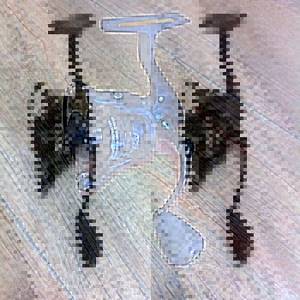
The best reels for light spinning
Shimano Nasci
This model is considered the number 1 tackle for light spinning fishing.
Good for beginners. It's inexpensive. Available with different types of spools - classic and small-profile. Virtually no backlash. Fishermen especially note its smooth motion.
Ryobi Ecusima
One of the most popular models among fans of light spinning fishing. Has little weight. Considered a budget model. It lays the braided line well and reliably, the smooth and sensitive stroke allows the use of fishing line of the smallest diameters.
Shimano Cardiff 301A
A very convenient multiplier, designed for the left hand.
Contains 5 ball bearings and 1 roller bearing.
The lightness of the model is ensured by the aluminum body.
Salmo Elite TROLL 7
Another cartoon whose body is made using graphite and plastic.
It has a particularly smooth ride.
Other models
In addition to the above-mentioned world-famous models, the company also produces others. Some anglers, when they see the Ryobi badge, immediately grab it, so they understand that this is an excellent quality reel. Among these are the following models:
- Apllause features a wide spool, front drag, roller design that prevents warp from tangling.
- Slem is chosen for working with the thinnest cords, but the model is also available with large spools, it is distinguished by a black body design and excellent overall performance.
- Spiritual is one of the new models, it is distinguished by a new modification of the handle, in all other respects the company adheres to the classics, the reel perfectly withstands power loads, is light, strong, durable with skillful handling.
- Tresor is a budget option, the price/quality ratio is excellent. The rubberized handle is a feature of the model; the product is suitable for both a novice fisherman and an experienced angler. The reel is produced with different spool sizes, so it can be used on different forms of spinning rods.
There is no point in further listing the branded models produced; each of them will differ from an identical reel from another manufacturer.
Stinger Phantom XW
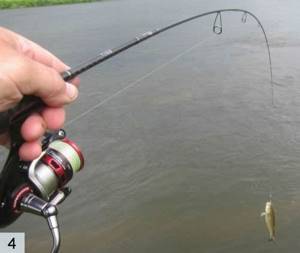
I purchased this reel at one time as a backup for the Dive Surtate. On multi-day fishing trips in remote areas, many things can happen - for example, breakage or falling into the water. Often repairs in the field are simply impossible, so it is useful to be on the safe side and have a spare unit. So the Phantom appeared in my bag as a spare, especially since it has protection against water - it can painlessly withstand being under water when falling, say, into a river for up to three minutes.
Once it turned out that for fishing in a specific area a thin line was required, and it was on the Stinger. I didn’t want to rewind the cord on “Dive” - so a “replacement player” entered the field. To say that I was surprised by his work is an understatement. Casting, laying, friction, precise work when fixing the bow - everything was good. I went fishing and caught some nice fish. On the next fishing trip, I decided to fish with the Phantom again - I was just wondering how much resource this very budget model would have. But “Stinger” went through almost the entire season, courageously fulfilling all the tasks that I set for it (photo 4) .
Stinger Phantom XW Specifications:
- turned handle
- gear ratio 5.2:1;
- waterproof bearings 6+1;
- friction pull 4 kg;
- timber capacity 0.15 mm – 180 m; 0.2 mm – 100 m.
By the way, when I pick up the Stinger Phantom, I begin to guess who the “dad” of the Innova Ultralight was. Because I knew about “mother” for a long time when I started fishing with an Innova 2500 reel on a jig.
